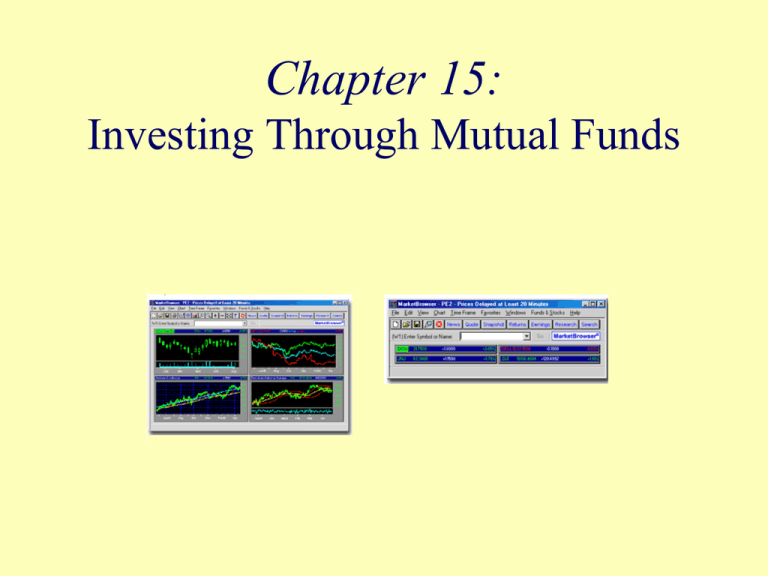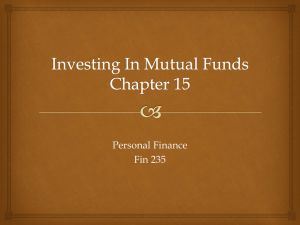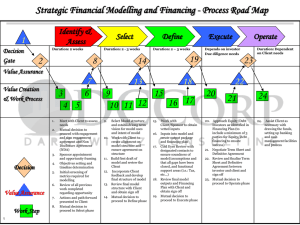Investing in Mutual Funds
advertisement

Chapter 15: Investing Through Mutual Funds Objectives Identify why people invest in mutual funds. Distinguish among the four major objectives of mutual funds. Classify mutual funds by portfolio. List the unique benefits of mutual funds. Objectives Describe the various charges and fees associated with investing in mutual funds. Explain how to select a mutual fund in which to invest. Recognize valid reasons for selling a mutual fund investment. Investing Through Mutual Funds MUTUAL FUND . . . open-end investment company combining funds of investors who have purchased shares in a diversified portfolio of securities. What is a Mutual Fund? A pool of money Managed by a professional investor Manager works for an investment firm Each fund has a specific objective Over 6,000 funds to choose from Figure 15.1 Three Reasons Why People Purchase Mutual Funds Diversification funds of many investors are pooled and used to purchase a variety of investments Professional management who is the fund’s manager? managers can change Convenience phone mail 16-3 Reasons for Investing Through Mutual Funds New/more types of funds Few or no sales charges Some performed better than common stock Widespread marketing Selection is easier Reasons for Investing Through Mutual Funds Dispense profits to investors Investors expect dividend income Investors expect price appreciation Closed and Open End Funds Closed end fund (10% of funds) limited number of shares issued initially then can only purchase shares from another investor willing to sell theirs Open end fund (90% of funds) no limitations on the number of shares the investment company can issue shares are issued and redeemed by the investment company Net Asset Value portfolio market value - liabilities the number of shares outstanding Offer price = NAV + sales commission Objectives of Mutual Funds Current income Long-term growth Growth and income Balanced Classification of Mutual Funds Common stock Balanced Bond Specialty Money market Classification of Mutual Funds COMMON STOCK: Aggressive growth Small company Growth Sector Value Global/international Growth and income Index Unique Benefits of Mutual Funds Recordkeeping/reporting Easy purchase and sale Automatic reinvestment IRS-qualified tax-sheltered retirement Withdrawal plans Collateral for loans Costs of Investing Through Mutual Funds Hidden fees Deferred load Redemption 12b-1 Disclosure of Fees “Which is better, load or no-load?” Management Fees and Other Charges One-time sales load fees 12b-1 fees •Cannot exceed more than 1% of the funds assets per year •For a fund to be classified as no-load these fees cannot exceed more than 0.25% of the funds assets per year. Load vs. No Load Funds Load Fund pay a commission to a sales agent when you buy shares usually 3-8% No Load Fund no sales charge paid purchased directly from the investment company usually have an 800 number you can call Management Fees and Other Charges Management fee charged yearly (.25 - 1%) based on a percentage of the funds asset value Contingent deferred sales load charged upon withdrawal of funds (1-6%) decreases with time held 12b-1 fees fee to defray advertising and marketing costs of the fund Strategies for Selecting a Mutual Fund Match goals Locate sources of comparative performance data Financial press (i.e. Wall Street Journal, Barron’s) Magazines (i.e. Fortune, Kiplinger’s) Specialized mutual fund publications Strategies for Selecting a Mutual Fund Interpret comparative performance information over time Long-term/short-term performance Size of fund Fund performance in up/down markets Read prospectuses and annual reports When To Sell Fund performs poorly compared with similar funds Perception of economic trends indicates business cycle will smooth out soon Fund grows too rapidly or becomes too large Fund taken over by new manager Investment goals become more conservative Need cash








